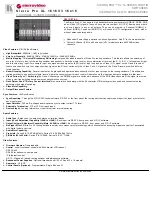
33
NOTE:
•
To avoid negotiation failure, make sure that at least one speed option is supported at both ends.
•
Among the auto-negotiation-capable Layer 2 ports, the FE copper ports support only the
10
and
100
keywords, the GE copper ports support all keywords, and the GE fiber ports support only
the
100
and
1000
keywords.
Examples
# Configure the port Ethernet 1/0/1 to use 10 Mbps and 1000 Mbps for speed negotiation.
<Sysname> system-view
[Sysname] interface ethernet 1/0/1
[Sysname-Ethernet1/0/1] speed auto 10 1000
storm-constrain
Syntax
storm-constrain
{
broadcast
|
multicast
|
unicast
}
pps
max-values min-values
undo storm-constrain
{
all
|
broadcast
|
multicast
|
unicast
}
View
Ethernet interface view
Default level
2: System level
Parameters
all
: Disables storm control for all types of packets: broadcast, multicast, and unknown unicast.
broadcast
: Enables or disables broadcast storm control.
multicast
: Enables or disables multicast storm control.
unicast
: Enables or disables unknown unicast storm control.
pps
: Sets storm control thresholds in pps.
max-values
: Sets the upper threshold.
min-values
: Sets the lower threshold, ranging from 1 to
max-values
.
Description
Use
storm-constrain
to enable broadcast, multicast, or unknown unicast storm control on an
Ethernet port.
Use
undo storm-constrain
to disable storm control.
By default, traffic storm control is disabled.
To achieve desirable storm protection effect, avoid configuring both the
storm-constrain
command
and any storm suppression command (
unicast-suppression
,
multicast-suppression
, and
broadcast-suppression
) on a port.
An upper threshold must be greater than or equal to the corresponding lower threshold. Hewlett
Packard Enterprise does not recommend configuring the same value for the two thresholds.
Examples
# Enable unknown unicast storm control on Ethernet 1/0/1, setting the upper and lower thresholds to
200 pps and 150 pps.
<Sysname> system-view
















































